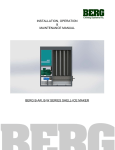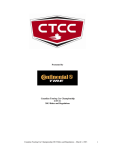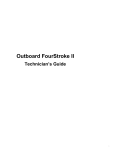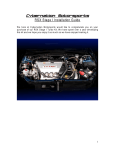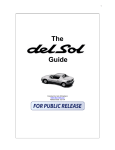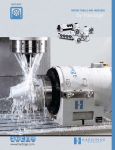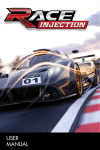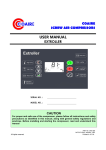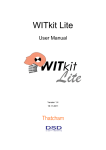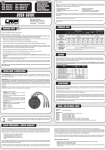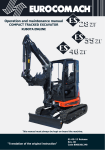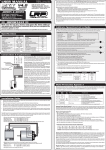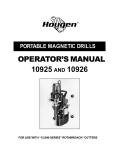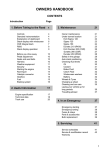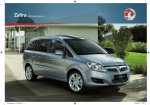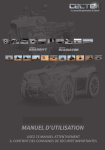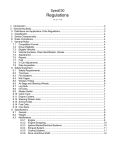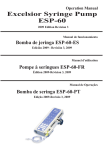Download CTCC 2012 Rules and Regulations
Transcript
Presented by Canadian Touring Car Championship (CTCC) 2012 Rules and Regulations Canadian Touring Car Championship 2012 Rules and Regulations – January 9, 2012 1 2012 Rules and Regulations These rules and regulations are designed to govern and provide for the orderly and safe conduct of all CTCC events. By registration for the CTCC and participation in the CTCC events, all participants are deemed to have read and complied with all rules and regulations of the sanctioning body, of the CTCC and all supplementary regulations of the racing events. No expressed or implied warranty of safety or fitness for a particular purpose shall result in publication of, or compliance with these rules and regulations. These rules and regulations are intended only as a guide for the conduct of sport and are in no way a guarantee against injury or death to participants, spectators or others. Mission Statement To provide Canadian race fans with close and exciting competition between some of Canada’s best drivers in race cars based on their original production models. Vision Statement To operate a truly Canadian Road Racing Championship that provides marketing value to Canadian corporations looking to energize their brands and drive sales. Canadian Touring Car Championship 2012 Rules and Regulations – January 9, 2012 2 Contents 1.0 2.0 3.0 4.0 5.0 6.0 About CTCC 1.1 Contact Information 1.2 Sanctioning 1.3 Rules and Regulations 1.4 Hierarchy of Regulations 1.5 Licensing 1.6 Advertising and Promotion Release 1.7 Broadcast and Other Rights Registration 2.1 Application 2.2 Fees 2.3 Registration Package 2.4 Entry Restrictions 2.5 Car Number Request Events 3.1 Team Representative 3.2 Mandatory Attendance 3.3 Paddock Parking 3.4 Code of Conduct 3.5 Competitor/Team Uniforms 3.6 Communications Equipment 3.7 Awards 3.8 Participant Credentials 3.9 Event Procedures Vehicle Eligibility and Modifications 4.1 Vehicle Specifications 4.2 Tires 4.3 Vehicle Appearance 4.4 Decals 4.5 Driver Safety Equipment 4.6 Vehicle Safety Equipment Scoring 5.1 General Provisions 5.2 Competitor Points 5.3 Competitor Finishing Position Points 5.4 Competitor Bonus Points 5.5 Manufacturer Points Vehicle Classification 6.1 Vehicle Eligibility 6.2 Race Weight 6.3 Vehicle List 4 4 4 4 4 5 5 5 6 6 6 6 6 6 7 7 7 7 7 7 8 8 8 8 9 10 31 32 32 32 33 34 34 34 34 34 35 35 35 35 35 Figure 1.0 – Vehicle Diagram - decal layout 39 Figure 2.0 – Shirt/Suit Diagram – patch layout 40 Canadian Touring Car Championship 2012 Rules and Regulations – January 9, 2012 3 1.0 About CTCC 1.1 Contact Information Canadian Touring Car Championship 1102-71 Simcoe Street Toronto, Ontario M5J 2S9 www.touringcar.ca Tel: 416-707-0358 1.2 Fax: 416-506-1646 Sanctioning CTCC is sanctioned by ASN Canada FIA ASN Canada FIA 115-2155 Leanne Boulevard Mississauga, Ontario L5K 2K8 www.asncanada.com Tel: 905-403-9000 1.3 Rules and Regulations 1.3.1 1.3.2 1.3.3 1.3.4 1.3.5 1.3.6 1.4 Fax: 905-403-8448 In case of dispute between specifications and measurements stated in Imperial and Metric, the Metric measurement shall be considered as being authentic and will prevail. The Regulations may only be amended or altered after consultation between the sanctioning body and CTCC. CTCC and the sanctioning body competition bulletins shall be considered a part of, and have the same validity as these Regulations. As of the first day of January of each year, CTCC Regulations for that year supersede all versions from previous years. As of the first day of January of each year, all CTCC bulletins from the previous year are void. The official language of CTCC is English. Hierarchy of Regulations The hierarchy of regulations is as follows; 1. ASN Regulations. 2. CTCC Rules and Regulations. 3. CTCC Bulletins from CTCC Officials. Bulletins are effective immediately when posted on the CTCC website or the CTCC bulletin board at events. 4. Supplementary regulations of each event. 5. Instructions from CTCC Officials. Canadian Touring Car Championship 2012 Rules and Regulations – January 9, 2012 4 1.5 Licensing All Canadian competitors shall hold an ASN Canada FIA National Race License. Competitors from outside Canada must hold a minimum of a National or Pro licence issued by an FIA-affiliated racing organization and an ASN Canada FIA membership. When the driver is not the entrant, the entrant must hold an ASN Canada FIA Entrant’s Licence. 1.6 Advertising and Promotion Release Each Competitor, by participating in the CTCC, grants to CTCC, its duly authorized agents and assigns, an exclusive license to use and sublicense his or her name, likeness and performance, including photographs, images and sounds of such Competitor and/or any vehicle(s) with respect to which the Competitor competes in CTCC, in any way, medium or material (including but not limited to broadcasts by and through television, cable television, radio, pay-per-view, closed circuit television, satellite signal, digital signal, film productions, audiotape productions, transmissions over the internet, public and private online services authorized by CTCC, sales and other commercial projects, and the like) for promoting, advertising, broadcasting, recording or reporting of CTCC events before, during and after such event, and each Competitor relinquishes to CTCC exclusively and in perpetuity all rights thereto for such purposes. 1.7 Broadcast and Other Rights Each Competitor, by participating in the CTCC, acknowledges that CTCC, and its licenses and assigns, exclusively and in perpetuity owns any and all rights to broadcast, transmit, film, tape, capture, overhear, photograph, collect or record by any means process, medium or device (including but not limited to television, cable television, radio, pay-per-view, closed circuit television, satellite signal, digital signal, film productions, audiotape productions, transmissions over the internet, public and private online services authorized by CTCC, sales and other commercial projects, and the like), whether or not currently in existence, all images, sounds and data (including but not limited to in-car audio, in-car video, in-car radio, other electronic transmissions between cars and crews, and timing and scoring information) arising from or during any CTCC Event or the Competitor’s performance in the Event, and that CTCC is and shall be the sole owner of any and all copyrights, intellectual property rights, and proprietary rights worldwide in and to these works and in and to any works, copyrightable or otherwise, created from the images, sounds and data arising from or during a CTCC Event and the Competitor’s performance in the Event. Each Competitor agrees not to take any action, nor cause others to take any action, nor enter into any third party agreement which would contravene, diminish, encroach or infringe upon these CTCC rights. Canadian Touring Car Championship 2012 Rules and Regulations – January 9, 2012 5 2.0 Registration 2.1 Application 2.1.1 2.1.2 2.1.3 2.1.4 2.1.5 2.2 Fees 2.2.1 2.2.2 2.2.3 2.2.4 2.2.5 2.2.6 2.3 A competitor must submit a CTCC Registration Application and be accepted by CTCC before participating in an Event. The Application is available from the CTCC office and website. An Application for each car must be completed and sent to the CTCC office with proper payment of the Registration Fee. CTCC reserves the right, without notice, to accept or decline any Application for any reason and may change or limit the number of Applications accepted. Acceptance of the Application is not intended to be, nor shall it be considered in any way a contractual offer. The CTCC Registration Fee must be received by CTCC no later than March 31, 2012. The CTCC Registration Fee is non-refundable. The CTCC Event Entry Fee must be received by CTCC one week (7 days) prior to the first day of the event being entered. Competitors that preregister for the season (post-dated cheque(s) or credit card) may cancel provided notification is received by CTCC one week (7days) prior to the first day of the event being cancelled. Payment shall be made by credit card, cash, cheque, bank draft or money order payable to Corner2 Incorporated. The Fee for NSF cheques or any late payment shall be $500. Failure to satisfy outstanding payments may impede acceptance of entries at CTCC Events. Registration Package Upon acceptance of the Application, the competitor is eligible to; 2.3.1 2.3.2 2.3.3 2.4 Entry Restrictions 2.4.1 2.4.2 2.5 Participate in CTCC Events, including promotional events. Receive CTCC decals and patches. Receive schedules, announcements and CTCC news sent by email. CTCC reserves the right to limit the number of participants in a CTCC event. When the number of participating cars is limited, CTCC shall give preference to Competitors who have accumulated CTCC points. Car Number Request 2.5.1 The desired car number and two alternate choices shall be submitted on the CTCC Registration Form. Canadian Touring Car Championship 2012 Rules and Regulations – January 9, 2012 6 2.5.2 2.5.3 2.5.4 Car numbers will be issued to returning cars that register by March 1, 2012 on a priority basis followed by new entries. Car numbers shall be between 2 and 99 unless approved by CTCC. Car number 1 shall be reserved for the previous year Super Class champion. 3.0 Events 3.1 Team Representative Each team shall designate one person to act as the team representative. This person is the only person who may speak for the team OFFICIALLY, including filing verbal scoring or other inquiries and making changes and additions to the team’s credential list. If this person must be changed during the event, the Registrar, Chief of Timing and Scoring and CTCC Officials must be notified in writing. 3.2 Mandatory Attendance Competitors shall attend all drivers’ meetings, autograph sessions, promotion events and interviews as directed by CTCC. Exceptions must be confirmed in advance with CTCC Officials. The minimum penalty for not attending shall be $200.00 payable to CTCC. 3.3 Paddock Parking CTCC reserves the right to designate and assign paddock parking spaces for competitors. Teams (up to two vehicles) shall be prepared to work in a paddock space not more than 25 feet wide including trailer/transporter. Motor coaches and other support vehicles may be located in the paddock only upon CTCC approval. CTCC will work with track management and the event organizer to provide a professional presentation and to maximize sponsor and competitor exposure. 3.4 Code of Conduct All CTCC participants shall conduct themselves in a professional and respectful manner particularly in relations with other participants, officials, sponsor partners and the general public. All CTCC participants shall maintain the highest level of behaviour and sportsmanship and shall ensure that their actions are not detrimental to CTCC or motorsports in general. All CTCC participants are responsible for their guests at all times. 3.5 Competitor/Team Uniforms 3.5.1 3.5.2 Team members participating in CTCC must wear matching team uniforms, displaying the required patches as shown in Figure 2.0. Team uniform design must not interfere with the visibility of the required patches or be in conflict with CTCC Sponsors and must otherwise be deemed to be in good taste in the opinion of CTCC. Canadian Touring Car Championship 2012 Rules and Regulations – January 9, 2012 7 3.5.3 3.5.4 3.5.5 3.5.6 3.6 Competitors participating in CTCC must display the required patches on their suits as specified by CTCC. Patches on competitor suits and team uniforms must be sewn on or permanently glued, not taped or secured with other temporary means. A Competitor or team member whose uniform has damaged, missing or incorrect patches, will not be permitted to participate in CTCC sessions. It is strongly recommended (to be reviewed for 2013) that: car numbers be displayed on the upper back of competitor/team uniforms; or be wearing an armband with contrasting number. The recommended numbers shall be 50mm (2 inches) in height and centred on the uniform just below the collar. Communications Equipment It is the participant’s responsibility to ensure compliance with all local and federal Radio communications laws including applicable fees. It is mandatory that teams have two-way radio communications between crew and driver during all on-track sessions. No other radio communications are allowed to the vehicle during on-track sessions. 3.7 Awards CTCC awards TBA. Competitors must receive their awards in person. 3.8 Participant Credentials All registered drivers and crew shall wear their official CTCC credential during CTCC race events. Drivers are exempt during CTCC on-track sessions. Credentials may be replaced or changed at a cost of $200 each. Over crew availability is at the discretion of the event promoter. See event details. 3.9 Event Procedures 3.9.1 3.9.2 3.9.3 Changing tires on pre-grid is not permitted unless approved by a CTCC Official. Race vehicles arriving at the designated pre-grid should expect to see 5 minute, 3 minute and 1 minute signal boards prior to being released to the true grid or track. When unexpected delays are encountered a “Hold” signal board will be displayed. Race Vehicles arriving after the 5 minute board has been displayed will be placed at the back of the grid in the order that they arrive and will not be allowed to take their grid position. Any time there is to be a transfer of fuel there must be a separate designated person standing, holding an appropriate fire extinguisher. This person’s sole responsibility is to watch for and be prepared to react to a fire. Refuelling must not be done under an Canadian Touring Car Championship 2012 Rules and Regulations – January 9, 2012 8 3.9.4 3.9.4 4.0 awning or in a place where fumes may accumulate or a person may become trapped. All vehicles and competitors shall not leave the pit lane during any track session without permission from a CTCC Official. All vehicles and competitors shall report directly to the designated impound area after every qualifying and race session unless directed by a CTCC Official. Vehicle Eligibility and Modifications 4.0.1 Underlying Principle Unless the regulations state that you can do it, you cannot. 4.0.2 General Provisions Vehicles shall comply with ASN Regulations as well as the regulations herein. Canadian Touring Car Championship 2012 Rules and Regulations – January 9, 2012 9 4.1 - Vehicle Specifications B-Spec Class 4.1.1 - General Description B-Spec Class is the entry level category with strictly controlled modifications. 4.1.2 - Engine 4.1.2.1 All adjustments shall be at the manufacturer’s specification and/or within the manufacturer’s specified tolerances. 4.1.2.2 Touring Class Super Class Touring Class is the mid-level category where minimal modifications are permitted and typical maximum horsepower is 200. Super Class is the category for heavily modified touring cars where typical maximum horsepower is 300. Maximum cylinder overbore is 0.5mm. Maximum cylinder overbore is 1mm. Cosmetic plastic engine covers may Engine internals shall remain stock or be removed. as specified by CTCC, specifically no polishing of internals or port matching is allowed. All components shall be installed as per the manufacturer. 4.1.2.3 Changes resulting in a different stroke from OEM must be approved by CTCC. Engine internals are unrestricted except for forced-induction engines which shall remain stock unless specified by CTCC. The use of exotic material such as titanium is not permitted, except in the valve train, specifically valves, springs, keepers and retainers. Changes resulting in a different stroke from OEM must be approved by CTCC. 4.1.3 – Brakes Canadian Touring Car Championship 2012 Rules and Regulations – January 9, 2012 10 4.1.3.1 Brakes must be as delivered by the manufacturer for the vehicle model including rotor size, caliper size and number of caliper pistons. Replacement brake rotors may be used provided the replacement is of the same material and is within five percent of the OEM rotor dimension. Brakes are unrestricted. 4.1.3.2 ABS can only be OEM system for the car, aftermarket systems are not allowed. ABS may be removed or disabled. ABS can only be OEM system for the car, aftermarket systems are not allowed. ABS may be removed or disabled. 4.1.3.3 Brake proportioning valves may be added or changed. Unrestricted 4.1.3.4 Master cylinder bore diameter shall remain as OE. Unrestricted Standard replacement brake rotors/drums may be obtained from sources other than the original manufacturer provided they are the exact equivalent. 4.1.3.5 Any brake pad or lining may be used. Any brake pad or lining may be used. Any brake pad or lining may be used. 4.1.3.6 Original brake hoses may be replaced by braided stainless steel brake lines. Original brake hoses may be replaced by braided stainless steel brake lines. Original brake hoses may be replaced by braided stainless steel brake lines. 4.1.4 - Suspension Canadian Touring Car Championship 2012 Rules and Regulations – January 9, 2012 11 4.1.4.1 Competitors must use the OEM suspension or the upgraded manufactures suspension kit in its entirety. Competitors must use the OEM bump stops or the bump stops provided in the manufactures kit. If a manufacturer does not have a kit, then an individual competitor can request a kit. The requested kit must meet the following criteria: Any non-adjustable shock absorber intended for the specific make, model, and year car is allowed. The shock absorber must be installed in the original mounting location. Remote reservoir shocks are not permitted. Any springs up to a maximum spring rate of 500 pounds may be used. The spring must be installed in the original location. Threaded shock bodies or adjusters may be used. Suspension components and adjustments are unrestricted. Suspension components and adjustments are unrestricted. 4.1.4.2 Suspension pick-up points shall remain in their OEM location. Suspension pick-up points shall remain in their OEM location. Suspension pick-up points shall remain in their OEM location. Canadian Touring Car Championship 2012 Rules and Regulations – January 9, 2012 12 4.1.4.3 Minimum ride height is 152.4mm (six inches), to be measured at the lowest point of the rocker panels, but not to include welded seams or fasteners. Ride height will be measured utilizing the CTCC measurement equipment with the vehicle as-is without driver. 4.1.4.4 Maximum 2.5 degrees negative chamber is allowed on front and rear suspensions. Strut suspensions may de-camber wheels by the use of eccentric bushings at control arm pivot points, by the use of eccentric bolts (crash bolts) at the strut-tospindle, and/or by use of slotted adjusters at the top of the strut mounting plate. If upper strut slotted plates are used, they shall be located on existing chassis structure, utilizing the manufacturer’s original bolt holes and may not serve as reinforcement for that structure. On other forms of suspension, camber adjustment may be achieved by the use of shims and/or eccentric bushings. B Spec front and rear toe settings are unrestricted. Rear toe adjustments may be achieved by the use of shims. Minimum ride height is 76.2mm (three inches.) Ride height will be measured from the lowest part, or component, of the vehicle, excluding suspension, and complete wheels. Ride height will be measured utilizing the CTCC measurement equipment with the vehicle as-is without driver. Minimum ride height is 50.8mm (two inches.) Ride height will be measured from the lowest part, or component, of the vehicle, excluding suspension, and complete wheels. Ride height will be measured utilizing the CTCC measurement equipment with the vehicle as-is without driver. 4.1.5 - Exhaust Canadian Touring Car Championship 2012 Rules and Regulations – January 9, 2012 13 4.1.5.1 Any part of the exhaust system beyond the catalytic converter(s) may be replaced provided: A. Said replacement system retains the same original configuration, e.g., routing, single, dual, etc. B.The system exits from the body in the same approximate location(s) as the original. When an original equipment single exhaust system is cosmetically split into dual outlets, it is permitted to continue as a single system provided it exits in approximately the same location as one of the originals. 4.1.5.2 4.1.5.3 Exhaust pipes may not enter the driver’s compartment. Exhaust is unrestricted, including replacement exhaust manifold and headers or as specified by CTCC, except as specified in 4.1.5.2. Exhaust is unrestricted, including replacement exhaust manifolds and headers or as specified by CTCC, except as specified in 4.1.5.2. Exhaust manifold shall remain stock for turbo-charged vehicles. Exhaust manifold shall remain stock on turbo-charged vehicles unless specified by CTCC. Exhaust pipes may not enter the driver’s compartment. Exhaust pipes may not enter the driver’s compartment. 4.1.6 - Sound Limit Canadian Touring Car Championship 2012 Rules and Regulations – January 9, 2012 14 The maximum sound decibel limit is 104 dbA. The limit will be the same regardless of weather conditions at the individual tracks. Vehicles should measure approximately 5 dbA below the limit in warm, humid weather, so that in cooler, less humid weather they still measure below the limit. The sound variance does vary from car to car, so 5 dbA may be more or less than needed. Only sound level readings taken by CTCC are official. The maximum sound decibel limit is 104 dbA. The limit will be the same regardless of weather conditions at the individual tracks. Vehicles should measure approximately 5 dbA below the limit in warm, humid weather, so that in cooler, less humid weather they still measure below the limit. The sound variance does vary from car to car, so 5 dbA may be more or less than needed. Only sound level readings taken by CTCC are official. The maximum sound decibel limit is 104 dbA. The limit will be the same regardless of weather conditions at the individual tracks. Vehicles should measure approximately 5 dbA below the limit in warm, humid weather, so that in cooler, less humid weather they still measure below the limit. The sound variance does vary from car to car, so 5 dbA may be more or less than needed. Only sound level readings taken by CTCC are official. 4.1.7 - Chassis 4.1.7.1 Vehicles shall be production based with uni-body construction as delivered by the manufacturer. No change may be made to the vehicle chassis without CTCC approval. Vehicles shall be production based with uni-body construction as delivered by the manufacturer. No change may be made to the vehicle chassis without CTCC approval. Vehicles shall be production based with uni-body construction as delivered by the manufacturer. No change may be made to the vehicle chassis without CTCC approval. 4.1.7.2 Seam welding is permitted. Seam welding is permitted. Bodywork materials are unrestricted, except front facia/bumper covers which must be as original (OEM). Bodywork materials are unrestricted, except front facia/bumper covers which must be as original (OEM). 4.1.8 - Bodywork 4.1.8.1 Canadian Touring Car Championship 2012 Rules and Regulations – January 9, 2012 15 4.1.8.2 No additional holes may be cut into the exterior of the bodywork unless approved by CTCC. No additional holes may be cut into the exterior of the bodywork unless approved by CTCC. Up to two additional holes may be cut into the front fascia for the purpose of additional brake cooling. 4.1.8.3 Vehicles shall use OEM or OE-style side mirrors in the OE locations. Vehicles shall use OEM or OE-style side mirrors in their OE locations. Tow hooks must be flexible (ie. metal or strap). Acceptable solutions are shown below. The flexible metal tow hook shall not extend more than 20mm from the bodywork. Tow hooks must be strong enough to allow the vehicle to be towed or moved from any position or direction. Tow hooks must be flexible (ie. metal or strap). Acceptable solutions are shown below. The flexible metal tow hook shall not extend more than 20mm from the bodywork. Tow hooks must be strong enough to allow the vehicle to be towed or moved from any position or direction. 4.1.8.4 Tow hooks must be flexible (ie. metal or strap). Acceptable solutions are shown below. The flexible metal tow hook shall not extend more than 20mm from the bodywork. Tow hooks must be strong enough to allow the vehicle to be towed/moved from any position or direction. 4.1.8.4 Images 4.1.9 - Drive Train Canadian Touring Car Championship 2012 Rules and Regulations – January 9, 2012 16 4.1.9.1 The flywheel/clutch assembly (flywheel, pressure plate and clutch disc) may be replaced with an aftermarket assembly that is interchangeable (using the same mounting holes) and the same dimensions as OEM. This assembly shall weigh at least eighty percent of the OEM weight and utilize the OEM starter motor. 4.1.9.2 Drive train internals are unrestricted provided the OEM housing is maintained. Sequential or X-Trac transmissions are not allowed. 4.1.10 - Ignition System 4.1.10.1 Authorized spark plugs listed in spark plug manufacturer’s application charts, owner’s manual, manufacturer’s shop/service manual, or equivalent justified by one cross reference chart. Use of resistor- or non resistor spark plug allowed. All electrical components including alternator and ECU are unrestricted or as specified by CTCC. In-car changes to the ECU tuning or boost level by the driver is prohibited. All electrical components including alternator and ECU are unrestricted or as specified by CTCC. In-car changes to the ECU tuning or boost level by the driver is prohibited. 4.1.10.2 OEM ECU/PCMs is required. Manufactures may provide an approved ECU/PCM re-flash for off non road use. Manufacturers may provide a stability control override procedure or module. Canadian Touring Car Championship 2012 Rules and Regulations – January 9, 2012 17 4.1.10.3 “Performance” specifications from the manufacturer that go beyond those listed on a specification line for a car will not be considered valid. 4.1.11 - Induction System 4.1.11.1 The unmodified OEM intake manifold and throttle body shall be used. Intake manifolds shall be OE or OEstyle aftermarket. Intake manifold preparation is unrestricted. Individual throttle bodies are not allowed unless specified by CTCC. 4.1.11.2 Ram-Air is not allowed. Engine ram air is allowed provided it is integral to the front facia or utilizes existing openings in the front facia. 4.1.11.3 Superchargers and/or turbochargers must be OEM complete including the airbox to the exit of the supercharger and/or turbocharger or as specified by CTCC. Superchargers and/or turbochargers must be OEM complete including the airbox to the exit of the supercharger and/or turbocharger or as specified by CTCC. 4.1.11.4 Supercharged cars must use OEM pulleys or approved OEM sized pulleys. Supercharged cars must use OEM pulleys or approved OEM sized pulleys. Canadian Touring Car Championship 2012 Rules and Regulations – January 9, 2012 18 4.1.11.5 Vehicles may be required to install an intake restrictor and/or run with boost and/or rpm limits as specified by CTCC. Only restrictor plates supplied by the championship will be accepted. Vehicles may be required to install an intake restrictor and/or run with boost and/or rpm limits as specified by CTCC. Only restrictor plates supplied by the championship will be accepted. Vehicles may be required to install an intake restrictor and/or run with boost and/or rpm limits as specified by CTCC. Restrictors must be mounted in front of the throttle body within 100mm or immediately behind the throttle body. 4.1.11.6 For forced induction vehicles, the published maximum boost limit may not be exceeded. by 2 psi for a period of 0.15 seconds per occurrence and up to a maximum of 0.5 seconds per lap. For forced induction vehicles, the published maximum boost limit may not be exceeded. by 2 psi for a period of 0.15 seconds per occurrence and up to a maximum of 0.5 seconds per lap. 4.1.11.7 Turbo intercoolers are unrestricted and may be relocated. 4.1.11.8 Air filter elements may be substituted Air filter systems located before the throttle body may be modified with other air filters of equivalent specifications and fit in the standard or substituted. location with no modifications. The filter element must be substantiated by a minimum of one (1) manufacturer cross-reference for specific vehicle application. Air filter systems located before the throttle body may be modified or substituted. 4.1.12 - Fluids 4.1.12.1 Engine cooling system is unrestricted with the exception of intercoolers (see 4.1.11). Engine cooling system is unrestricted with the exception of intercoolers (see 4.1.11). Canadian Touring Car Championship 2012 Rules and Regulations – January 9, 2012 19 4.1.12.2 Engine cooling system fluid is restricted to water with an additive to reduce the surface tension of the water. Ethylene Glycol may not be used. Engine cooling system fluid is restricted to water with an additive to reduce the surface tension of the water. Ethylene Glycol may not be used. Engine cooling system fluid is restricted to water with an additive to reduce the surface tension of the water. Ethylene Glycol may not be used. 4.1.12.3 Brake fluids may be substituted with other equivalent manufacturer’s specification. Brake fluids are unrestricted. Brake fluids are unrestricted. 4.1.12.4 Lubricants may be substituted with any lubricant. Additives are unrestricted. Lubricants may be substituted with any lubricant. Additives are unrestricted. Lubricants may be substituted with any lubricant. Additives are unrestricted. Vehicles may only use OEM rear wing or OE-style aftermarket model as approved by CTCC. Vehicles may use an aftermarket rear wing. 4.1.13 - Aerodynamics – Rear Wings 4.1.13.1 4.1.13.2 No part of a rear wing assembly shall extend beyond the perimeter of the rear bumper or beyond the width of the vehicle as shown in the diagram below. Canadian Touring Car Championship 2012 Rules and Regulations – January 9, 2012 20 4.1.13.2 Image 4.1.13.3 The highest part of a rear wing assembly must be no higher than the highest point of the roof. 4.1.13.4 Hatchback rear wing assembly shall not extend more than 101.6mm (4 inches) above the highest point of the roof. 4.1.14 - Aerodynamics – Front Splitter 4.1.14.1 No additional splitter may be added to the OEM fascia. An additional splitter may be added to the OEM fascia. 4.1.14.2 No part of a front splitter may extend forward 38.1mm (1.5 inches) of the front bumper and/or rear of the front axle centre line. 4.1.14.3 The exposed top surface of the splitter shall not extend forward more than 76.2mm (3 inches). Canadian Touring Car Championship 2012 Rules and Regulations – January 9, 2012 21 4.1.15 - Aerodynamics – Rear Diffusers Rear diffusers are not allowed. Rear diffusers are not allowed. Front and rear bumper extensions are not allowed. Front and rear bumper extensions are not allowed. 4.1.16.2 Additional front or rear dive-planes are not allowed. Additional front or rear dive-planes are not allowed. 4.1.16.3 Additional holes may not be cut into the front or rear bumper covers. Additional holes may not be cut into the rear bumper covers. 4.1.17 – Lights 4.1.17.1 All vehicles must have operational OE or aftermarket replica headlight and taillight assemblies in place in the stock positions. All vehicles must have operational OE or aftermarket replica headlight and taillight assemblies in place in the stock positions. All vehicles must have operational OE or aftermarket replica headlight and taillight assemblies in place in the stock positions. 4.1.17.2 Headlights and taillights must be covered with clear tape. Headlights and taillights must be covered with clear tape. Headlights and taillights must be covered with clear tape. 4.1.17.3 All vehicles must compete with headlights and taillights illuminated in all on-track sessions regardless of weather conditions. All vehicles must compete with headlights and taillights illuminated in all on-track sessions regardless of weather conditions. All vehicles must compete with headlights and taillights illuminated in all on-track sessions regardless of weather conditions. 4.1.16 - Aerodynamics - General 4.1.16.1 4.1.18 - Vehicle Compliance Canadian Touring Car Championship 2012 Rules and Regulations – January 9, 2012 22 If CTCC determines prior to the start of a qualifying or race session that a vehicle does not comply with the applicable technical specifications, the vehicle may not be allowed to compete unless the identified deficiency can be corrected sufficiently so that it will not affect safety and will not provide a competitive advantage over other vehicles. If CTCC determines prior to the start of a qualifying or race session that a vehicle does not comply with the applicable technical specifications, the vehicle may not be allowed to compete unless the identified deficiency can be corrected sufficiently so that it will not affect safety and will not provide a competitive advantage over other vehicles. The minimum penalty for an infraction of CTCC Regulations is $500.00 payable to CTCC. The minimum penalty for an infraction The minimum penalty for an infraction of CTCC Regulations is $500.00 of CTCC Regulations is $500.00 payable to CTCC. payable to CTCC. 4.1.19 - Dashboard The dashboard assembly must remain as delivered by the manufacturer but may be modified for roll cage installation purposes. 4.1.20 - Windows 4.1.20.1 If the Championship determines prior to the start of a qualifying or race session that a vehicle does not comply with the applicable technical specifications, the vehicle may not be allowed to compete unless the identified deficiency can be corrected sufficiently so that it will not affect safety and will not provide a competitive advantage over other vehicles. The dashboard assembly must remain as delivered by the manufacturer but may be modified for roll cage installation purposes. The dashboard assembly must remain as delivered by the manufacturer but may be modified for roll cage installation purposes. All vehicles must use a stock, OE equivalent, safety glass windshield, or 6mm (1/4 inch) minimum thickness un-tinted Lexan replacement, mounted in the stock location, at the stock angle and maintaining the stock profile. All vehicles must use a stock, OE equivalent, safety glass windshield, or 6mm (1/4 inch) minimum thickness untinted Lexan replacement, mounted in the stock location, at the stock angle and maintaining the stock profile. Canadian Touring Car Championship 2012 Rules and Regulations – January 9, 2012 23 4.1.20.2 Side and rear windows may be replaced with plexiglass or Lexan. Side and rear windows may be replaced with plexiglass or Lexan. 4.1.20.3 Additional holes are permitted in the side or rear windows for the purpose of cooling or venting. Holes in the rear window are only permitted in the bottom 76.2mm (3 inches) of the window. Additional holes are permitted in the side or rear windows for the purpose of cooling or venting. Holes in the rear window are only permitted in the bottom 76.2mm (3 inches) of the window. 4.1.20.4 Both the driver’s side and passenger’s side windows shall be in the down position during all track sessions. Both the driver’s side and passenger’s side windows shall be removed or in the down position during all track sessions. Both the driver’s side and passenger’s side windows shall be removed or in the down position during all track sessions. 4.1.20.5 Sunroofs shall be replaced by a permanently installed metal panel. Motors, rails and cables shall be removed. Sunroofs shall be replaced by a permanently installed metal panel. Motors, rails and cables shall be removed. Sunroofs shall be replaced by a permanently installed metal panel. Motors, rails and cables shall be removed. 4.1.21 - Transponder Vehicles shall be equipped with an AMB TranX lap timing transponder securely installed on the front subframe with an unobstructed downward path for the signal. Vehicles shall be equipped with an AMB TranX lap timing transponder securely installed on the front subframe with an unobstructed downward path for the signal. Vehicles shall be equipped with an AMB TranX lap timing transponder securely installed on the front subframe with an unobstructed downward path for the signal. 4.1.22 - Data Acquisition Canadian Touring Car Championship 2012 Rules and Regulations – January 9, 2012 24 4.1.22.1 Any team using data acquisition shall make any and all data, configuration files, logging channels, etc., including any other system related software, available to CTCC upon request. Teams are required to be able to burn data onto a CD at the track. Any team using data acquisition shall make any and all data, configuration files, logging channels, etc., including any other system related software, available to CTCC upon request. Teams are required to be able to burn data onto a CD at the track. Any team using data acquisition shall make any and all data, configuration files, logging channels, etc., including any other system related software, available to CTCC upon request. Teams are required to be able to burn data onto a CD at the track. 4.1.22.2 All vehicles must have an operating forward-facing video camera during all on-track sessions. The video must be in a format that is easily viewed immediately after the session on CTCC equipment or on a screen of at least 15 inches. All vehicles must have an operating forward-facing video camera during all on-track sessions. The video must be in a format that is easily viewed immediately after the session on CTCC equipment or on a screen of at least 15 inches. All vehicles must have an operating forward-facing video camera during all on-track sessions. The video must be in a format that is easily viewed immediately after the session on CTCC equipment or on a screen of at least 15 inches. Canadian Touring Car Championship 2012 Rules and Regulations – January 9, 2012 25 4.1.22.3 All vehicles logging data shall as a minimum log lap time, engine rpm, throttle position, lateral Gs, longitudinal Gs, one front wheel speed and one rear wheel speed. The data system must have enough memory to be able to record all the required data for the entire length of track session. The wheel speed sensors/triggers must have a fine enough resolution to show wheel slippage. Vehicles utilizing forced induction shall also log engine temperature, manifold pressure and inlet air temperature. All vehicles logging data shall as a minimum log lap time, engine rpm, throttle position, lateral Gs, longitudinal Gs, one front wheel speed and one rear wheel speed. The data system must have enough memory to be able to record all the required data for the entire length of track session. The wheel speed sensors/triggers must have a fine enough resolution to show wheel slippage. Vehicles utilizing forced induction shall also log engine temperature, manifold pressure and inlet air temperature. All vehicles logging data shall as a minimum log lap time, engine rpm, throttle position, lateral Gs, longitudinal Gs, one front wheel speed and one rear wheel speed. The data system must have enough memory to be able to record all the required data for the entire length of track session. The wheel speed sensors/triggers must have a fine enough resolution to show wheel slippage. Vehicles utilizing forced induction shall also log engine temperature, manifold pressure and inlet air temperature. 4.1.22.4 Forced induction vehicles shall be required to have a telltale boost gauge or boost sensor installed as specified by CTCC. The sensors must be threaded into the intake manifold if it is aluminum or may be connected via a hose no longer than 50mm if the manifold is plastic. Forced induction vehicles shall be required to have a telltale boost gauge or boost sensor installed as specified by CTCC. The sensors must be threaded into the intake manifold if it is aluminum or may be connected via a hose no longer than 50mm if the manifold is plastic. Canadian Touring Car Championship 2012 Rules and Regulations – January 9, 2012 26 4.1.22.5 CTCC may install GPS Data Loggers in any vehicle during any official session. All vehicles shall be equipped with a Traqmate GPS Antenna and GPS Mounting Tray and maintained in like-new condition. CTCC may install GPS Data Loggers in any vehicle during any official session. All vehicles shall be equipped with a Traqmate GPS Antenna and GPS Mounting Tray and maintained in like-new condition. CTCC may install GPS Data Loggers in any vehicle during any official session. All vehicles shall be equipped with a Traqmate GPS Antenna and GPS Mounting Tray and maintained in like-new condition. 4.1.23 - Fuel Vehicles shall use Sunoco 94 race fuel. All race fuel shall be purchased through the CTCC official fuel supplier. Vehicles shall be equipped with a fuel sampling port at or just above the injector rails. This port must be a “Jiffy-Tite” male plug model number 22306 or 22406 or 22505 or 22506. Sample shown below. Vehicles shall use Sunoco 260 GTX race fuel. All race fuel shall be purchased through the CTCC official fuel supplier. Vehicles shall be equipped with a fuel sampling port at or just above the injector rails. This port must be a “Jiffy-Tite” male plug model number 22306 or 22406 or 22505 or 22506. Sample shown below. Vehicles shall use Sunoco 260 GTX race fuel. All race fuel shall be purchased through the CTCC official fuel supplier. Vehicles shall be equipped with a fuel sampling port at or just above the injector rails. This port must be a “Jiffy-Tite” male plug model number 22306 or 22406 or 22505 or 22506. Sample shown below. 4.1.23 Image 4.1.24 - Wheels Canadian Touring Car Championship 2012 Rules and Regulations – January 9, 2012 27 4.1.24.2 Wheel spacers are not allowed. Wheel spacers are allowed as long as the resulting track width remains within the track requirements. Wheel spacers must be hub-centric and sufficiently attached. Wheel spacers are allowed as long as the resulting track width remains within the track requirements. Wheel spacers must be hub-centric and sufficiently attached. 4.1.24.3 Wheel studs shall not extend past the face of the rim. Wheel studs shall not extend past the face of the rim. Wheel studs shall not extend past the face of the rim. 4.1.24.4 Tires and wheels must be inside the body work from the axle centerline up as viewed from above. Wheels are permitted any offset provided the tire tread (that portion of the tire that contacts the ground) does not protrude beyond the fender opening when viewed from the top perpendicular to the ground. Tires and wheels must be inside the body work from the axle centerline up as viewed directly from above. Tires and wheels must be inside the body work from the axle centerline up as viewed directly from above. 4.1.24.5 Required minimum wheel/rim diameter is fifteen (15) inches. Maximum wheel/rim width is seven (7) inches. Minimum Wheel/rim weight shall be 5.91kg (13 lbs). All wheels shall be of one-piece metal castings. All four wheels must be the same dimensional offset. Required minimum wheel/rim diameter is seventeen (17) inches, with the exception of the Mini Cooper S which shall be fifteen (15) inches. Required minimum wheel/rim diameter is seventeen (17) inches. 4.1.25 – Interior/Heater/Air Conditioner Canadian Touring Car Championship 2012 Rules and Regulations – January 9, 2012 28 Interiors may be removed including seats, seat brackets, carpet, carpet padding, OEM seat belts, interior trim, and headliners. Original radio/stereo audio equipment and air conditioner refrigerant systems may be removed. Heater cores, hoses, and all duct work must remain except duct work under seats. The manufacturer’s or aftermarket air conditioning system may be removed. Items that serve a dual purpose, such as the alternator/air conditioning compressor bracket, may not be substituted. Idler pulleys and belts may be substituted as needed when compressor is removed. 4.1.26 - Battery Batteries may be replaced with those of alternate manufacture provided they are of similar amp hour (Ah) capacity and weight. Battery must remain in stock location. Additional hold-down brackets are allowed. The hot terminal must be insulated. Interiors may be removed including seats, seat brackets, carpet, carpet padding, OEM seat belts, interior trim, and headliners. Original radio/stereo audio equipment and air conditioner refrigerant systems may be removed. Heater cores, hoses, and duct work may be removed. The manufacturer’s or aftermarket air conditioning system may be removed. Items that serve a dual purpose, such as the alternator/air conditioning compressor bracket, may not be substituted. Idler pulleys and belts may be substituted as needed when compressor is removed. Interiors may be removed including seats, seat brackets, carpet, carpet padding, OEM seat belts, interior trim, and headliners. Original radio/stereo audio equipment and air conditioner refrigerant systems may be removed. Heater cores, hoses, and duct work may be removed. The manufacturer’s or aftermarket air conditioning system may be removed. Items that serve a dual purpose, such as the alternator/air conditioning compressor bracket, may not be substituted. Idler pulleys and belts may be substituted as needed when compressor is removed. Battery size and location are unrestricted within the bodywork. Batteries located in the driver/passenger compartment shall be in a nonconductive marine-type container or equivalent. The hot terminal must be insulated. Battery size and location are unrestricted within the bodywork. Batteries located in the driver/passenger compartment shall be in a nonconductive marine-type container or equivalent. The hot terminal must be insulated. 4.1.27 - Other Canadian Touring Car Championship 2012 Rules and Regulations – January 9, 2012 29 4.1.27.1 Interior mirror(s) may be replaced with a multi-panel type mirror, but shall not extend beyond the confines of the interior. Interior mirror(s) may be replaced with a multi-panel type mirror, but shall not extend beyond the confines of the interior. Interior mirror(s) may be replaced with a multi-panel type mirror, but shall not extend beyond the confines of the interior. A radiator screen of minimum onefourth inch (1/4”) mesh may be added in front of the radiator, intercoolers, oil coolers and contained within the bodywork. A radiator screen of minimum onefourth inch (1/4”) mesh may be added in front of the radiator, intercoolers, oil coolers and contained within the bodywork. 4.1.27.2 Aftermarket steering wheels, and their required mounting modifications, are permitted. Removable steering wheels are permitted. 4.1.27.3 A radiator screen of minimum onefourth inch (1/4”) mesh may be added in front of the radiator and contained within the bodywork. Canadian Touring Car Championship 2012 Rules and Regulations – January 9, 2012 30 4.2 Tires 4.2.1 4.2.2 4.2.3 4.2.4 4.2.5 4.2.6 4.2.7 4.3 Vehicle Appearance 4.3.1 4.3.2 4.3.3 4.3.4 4.4 The specified tire for CTCC is the Continental Extreme Contact race tire. The Standard tire size for B-Spec shall be 205/50/15 (wet and dry) The standard tire size for Touring Class shall be 225/45R17 (wet and dry) with the exception of the Mini which shall be 225/45R15 (wet and dry). The standard tire size for Super Class shall be 245/40R17 (dry) and 225/45R17 (wet). Tire shaving and grooving is permitted. All tires shall be purchased in Canada through the CTCC tire dealer. Tires must be mounted showing the yellow Continental logo outwards. All CTCC participating vehicles shall be neat and clean in appearance. Any modifications to a vehicle shall be done in a way that maintains this requirement. CTCC reserves the right to prohibit a vehicle from appearing on course due to its appearance, including, but not limited to, damage sustained from an on-track incident at the current, or any previous, event. It is required that all support vehicles, including, but not limited to, pit carts, scooters, trailers, transporters, etc., be maintained in a similar manner. Decals 4.4.1 General Provisions 4.4.1.1 4.4.1.2 4.4.1.3 4.4.1.4 4.4.1.5 4.4.1.6 4.4.1.7 4.4.2 The display of all required CTCC decals at all times during a CTCC event is an eligibility requirement for CTCC vehicles. All required decals must be placed and displayed in the locations and positions specified by CTCC. No other decals may be within 100mm of the CTCC Mandatory Decals. Vehicles with damaged, missing, or incorrect CTCC decals may not be permitted to participate in CTCC events. Vehicles with decals identifying other series may not be permitted to participate in CTCC events. Sufficient contrast between required CTCC decals and the colour of the background must be maintained. CTCC Mandatory Decals must not be modified, cut, or trimmed in any way. No other decals are permitted on the windshield except those specified by CTCC. Reserved Area 4.4.2.1 The areas defined by the rear of the front wheel opening back to The centre of the front doors, and from the bottom of the window opening down to the bottom of the door, are reserved for CTCC Canadian Touring Car Championship 2012 Rules and Regulations – January 9, 2012 31 4.4.2.2 decals. No other decals are permitted on the windshield except those specified by CTCC. 4.4.2.2 from The areas defined by the side of the front bumper/splitter/air-dam the front of the vehicle to the front wheel opening, are reserved for Championship decals. 4.4.2.3 The area defined by the rear license plate is reserved for Championship decals. 4.4.2.3 4.4.2.4 4.4.3 Conflicting Sponsors 4.4.3.1 4.4.3.2 4.4.4 Vehicle sponsor identification and graphics are permitted, but must not interfere with CTCC decals, or be in conflict with CTCC Sponsor Partners and must otherwise be deemed to be in good taste in the opinion of CTCC. The determination and decision as to whether a Sponsor conflict exists, or whether any graphics are in poor taste, rests solely with CTCC, who reserves the right to order the removal, temporarily or permanently, of any and all such graphics. Mandatory Decals 4.4.4.1 4.4.4.2 4.4.4.3 4.4.4.4 4.5 No other advertising, lettering, or artwork may appear or interfere in any way with the reserved area. Vehicle graphics are acceptable in the reserved area, provided they are placed behind CTCC Mandatory Decals. See figure 1.0 for placement of mandatory decals. Competitors are responsible for their name decals as designated. Name shall be white and 76.2mm (3 inch) high, Arial Bold font. CTCC shall provide each competitor with a set of door panels and numbers, a number(s) for the front winshield and a number(s) for the rear window. CTCC shall provide the competitor with CTCC partner decals as required. Driver Safety Equipment 4.5.1 Safety Helmets Drivers shall use a safety helmet with standards defined in FIA Technical List # 25. It is strongly recommended that helmets be equipped with a Helmet Removal System Example (“Eject” System). http://argent.fia.com/web/fiapublic.nsf/A8EE0C152AEF7782C12576EB00592DC5/$FILE/L25_stan dards_for_helmets.pdf Canadian Touring Car Championship 2012 Rules and Regulations – January 9, 2012 32 4.5.2 Flame Resistant Clothing Drivers shall use flame resistant clothing with standards defined in FIA Technical List # 27. http://argent.fia.com/web/fiapublic.nsf/B36454CF926F3463C12577FF00414AE3/$FILE/L27_Appr oved_clothing_materials.pdf 4.5.3 Frontal Head Restraint Drivers shall use a frontal head restraint with standards defined in FIA Technical List # 29. http://argent.fia.com/web/fiapublic.nsf/A7EE5D940757889BC12577FA005B402F/$FILE/L29_Appr oved_FHR_systems.pdf 4.6 Vehicle Safety 4.6.1 Cut-off Switches Vehicles shall be equipped with a “Cut-off Switch” easily accessible from outside the Vehicle. This switch will cut all electrical circuits (ignition, fuel pumps, lights, alternator, etc.) but shall not affect the operation of the on-board fire extinguisher. The location of the switch shall be clearly marked by the official international marking – a red spark in a white-edged, blue triangle. The Switch or Switch Control must be located in front of the windshield on the driver’s side on either the cowl or fender, close enough to be accessed by the driver. Alternately, the switch may be mounted on the Roll Cage on the driver’s side on a bracket attached to the “A” pillar/down-tube, close enough to be accessed by the driver. No holes may be drilled in the cage tube to facilitate this installation. 4.6.2 Fire Suppression All vehicles shall be equipped with an on-board fire suppression system with a minimum of two nozzles. 4.6.3 Air Bag Systems Air bag systems shall be disarmed and may be removed. If so equipped, the rolling door lock mechanism may be deactivated by unplugging the components. Canadian Touring Car Championship 2012 Rules and Regulations – January 9, 2012 33 5.0 Scoring 5.1 General Provisions 5.1.1 5.1.2 5.1.3 5.1.4 5.1.5 5.1.6 5.2 Competitor Points 5.2.1 5.2.2 5.3 To qualify as a finisher and score finishing position points, a competitor shall have completed no less than 70% of the total race laps by the leader of that competitor’s class at the chequered flag. Races shall be of a timed length or of a pre-established distance. A qualifying session shall determine the starting positions for the first race of an event. The results of the first race of the event shall determine the starting position for the second race. Should a qualifying session be cancelled or unavailable, vehicles shall be gridded according to current points standing by class or another method as determined by CTCC. All vehicles and competitors shall report directly to the designated impound area after every qualifying and race session or be disqualified from that session unless directed by a CTCC Official. All vehicles and competitors shall not leave the pit lane during all qualifying and race sessions without permission from a CTCC official. Competitors shall be awarded points based on the results in each round and/or qualifying session within the Championship. Vehicles/competitors excluded from the results of a CTCC round for any Given reason will lose all finishing position points and bonus points earned in that particular round, and all competitors will score points based upon the new results. Competitor Finishing Position Points Finishing points shall be awarded for each round as follows; 1st 100 11th 50 5.4 2nd 95 12th 45 3rd 90 13th 40 4th 85 14th 35 5th 80 15th 30 6th 75 16th 25 7th 70 17th 20 8th 65 18th 15 9th 60 19th 10 10th 55 20th 5 Competitor Bonus Points 5.4.1 5.4.2 5.4.3 5 additional points shall be awarded to the competitor who sets the fastest official qualifying time in each class. 1 additional point shall be awarded to each competitor for each lap completed in each round. 10 additional points shall be awarded to the competitor that publishes their in-car video footage from one of the 2012 CTCC events on the CTCC Facebook Fan Page before the last event of the 2012 season. Canadian Touring Car Championship 2012 Rules and Regulations – January 9, 2012 34 5.5 Manufacturer Points CTCC shall maintain point standings to determine a Manufacturer Champion in each Class. The highest finishing vehicle shall earn Manufacturer Points for its finishing position in each Class based on the following; 1st 50 2nd 45 3rd 40 6.0 Vehicle Classification 6.1 Vehicle Eligibility 4th 35 5th 30 6th 25 7th 20 8th 15 9th 10 10th 5 Only vehicles listed herein will be eligible to compete in CTCC. Vehicles may be included or excluded during the year. Application for vehicle eligibility must be made to CTCC a minimum of 60 days before the first event the vehicle is expected to participate in. All non-standard engine/vehicle combinations must apply to CTCC for classification. 6.2 Race Weight 6.2.1 6.2.2 6.2.3 6.2.4 CTCC will establish a minimum weight for each eligible vehicle. Weights may be adjusted to equalize competition. CTCC will provide an official listing of minimum vehicle weights. Weight will be measured as the vehicle comes off the racetrack with driver aboard and the fluid levels as-is. 6.2.5 Ballasting is permitted. 6.3 Vehicle List B-Spec Class Vehicles Manufacturer Model Year 12- Weight (kg) 1272.8 Weight (lbs) 2800 Chevrolet Sonic Fiat Ford 500 Fiesta 1211- 1036.4 1170.5 2280 2575 Honda Fit 09- 1136.4 2500 Kia Rio 5-door 12- 1181.9 2600 Mazda Mini 2 Cooper 1107- 1045.5 1181.9 2300 2600 Nissan Versa 4/5 door 07-11 1250.0 2750 Nissan Versa 4/5 09-11 1136.4 2500 Comments 1796cc engine, 31mm maximum intake restrictor 1368cc engine 1596cc engine, 34mm maximum intake restrictor 1499cc engine, 34mm maximum intake restrictor 1591cc engine, 23mm maximum intake restrictor 1499cc engine 1598cc engine, 33mm maximum intake restrictor 1797cc engine, 35mm maximum intake restrictor 1598cc engine Canadian Touring Car Championship 2012 Rules and Regulations – January 9, 2012 35 door Nissan Versa 4/5 door Yaris 3/5 door Toyota 12- 1131.9 2490 1598cc engine 07- 1100.0 2420 1491cc engine Touring Class Vehicles Manufacturer Model Year 97-01 Weight (kg) 1159.1 Weight (lbs) 2550 Acura Integra Acura Audi RSX TT 02-06 01-08 1216.0 1181.9 2675 2600 Audi TT 09- 1181.9 2600 Ford Honda Focus Civic 00-07 01-05 1113.7 1216.0 2450 2675 Honda Civic 06- 1227.3 2700 Honda Civic 06- 1238.7 2725 Mazda Protege 00-03 1147.8 2525 Mazda Protege 00-03 1204.6 2650 Mazda Protégé 5 00-03 1147.8 2525 Mazda Mercedes RX8 C230 0301-05 1227.3 1136.4 2700 2500 Mini Cooper S 02-06 1113.7 2450 Mini Cooper S 07- 1113.7 2450 Comments 1.8 litre, lightened flywheel, 4.7 or 4.9 final drive, may use aftermarket cams K20A2 motor 1.8 litre turbo FWD, allow APX engine with stock boost map 2.0 litre turbo FWD, stock boost map 2.0 litre K20A2 motor with X2M5 6 speed transmission allowed OE brake calipers May use TSX caliper – 45018-SEA-JO2 (R) / 45019-SEA-JO2 (L) and brackets. 2.0 litre turbo, may use Mazdaspeed part #000-019352-KT, maximum boost limited allowed 13psi 2.5 litre allowed 2.0 lire turbo, maximum boost limit TBD 1.3 litre 1.8 litre supercharged, maximum boost limit TBD 1.6 litre supercharged, may use unmodified aftermarket flywheel Fidanza Part #177901, maximum boost limit allowed 14psi 1.6 litre turbo, aluminum flywheel FMIC allowed, maximum boost limit allowed 19psi Canadian Touring Car Championship 2012 Rules and Regulations – January 9, 2012 36 Nissan Nissan Toyota Scion VW Sentra XE Sentra Se-R Corolla tC Golf/Jetta/ New Beetle Golf/Jetta New Beetle VW 00-06 00-06 00-05 0599-06 1022.8 1113.7 1113.7 1193.2 1136.4 2250 2450 2450 2625 2500 06- 1181.9 2600 2.0 litre 2.5 litre 1.8 litre 2.4 litre 1.8 litre turbo, maximum boost limit allowed 14psi 2.0 litre turbo, maximum boost limit allowed 12psi Super Class Vehicles Manufacturer Model Year 04- Weight (kg) 1125.0 Weight (lbs) 2475 Acura TSX Acura RSX 02-06 1068.2 2350 Acura RSX 02-06 1125.0 2475 Audi A4 94- 1341.0 2950 Audi TT 99- 1341.0 2950 Audi A5 09- 1318.2 2900 BMW E46 99-06 1193.2 2625 BMW E46 99-06 1261.4 2775 BMW E90 05- 1261.4 2775 Chevrolet Cobalt 05-07 1181.9 2600 Chevrolet Cobalt 08- 1204.6 2650 Honda Accord 08- 1204.6 2650 Honda Civic 01-05 1125.0 2475 Honda Civic 06- 1125.0 2475 Hyundai Genesis 10- 1318.2 2900 Comments 2.4 litre, may use 70mm throttle body 2.0 litre, may use 70mm throttle body, Mugen Front Bumper 2.4 litre, may use 70mm throttle body, Mugen Front Bumper 2.0 litre turbo, maximum boost limit allowed 18psi 2.0 litre turbo, maximum boost limit allowed 18psi 2.0 litre turbo, maximum boost limit allowed 18psi 2.5 litre, maximum 70mm throttle body, 1740mm maximum rear fender width 2.8 or 3.0 litre, maximum 70mm throttle body, 1740mm maximum rear fender width 3.0 litre, maximum 70mm throttle body 2.0 litre supercharged, maximum boost limit allowed 22psi 2.0 litre turbo, maximum boost limit allowed 24psi 2.4 litre, maximum 70mm throttle body 2.4 litre, maximum 70mm throttle body 2.4 litre, maximum 70mm throttle body 2.0 litre turbo, may modify chassis at rear upper Canadian Touring Car Championship 2012 Rules and Regulations – January 9, 2012 37 Hyundai Lexus Tiburon IS300 96-08 98- 1159.1 1295.5 2550 2750 Mazda Mitsubishi RX8 EVO 03-08 09- 1136.4 1363.6 2500 3000 Pontiac Solstice GXP 06- 1295.5 2850 Subaru WRX 01- 1341.0 2950 VW Golf/Jetta 99-06 1181.9 2600 VW Golf/Jetta 06- 1272.8 2800 control arms, maximum boost limit allowed 19psi 2.7 litre 2.8 or 3.0 litre, may use 6 speed Getrag V160 transmission 2.0 litre turbo, stock boost map 2.0 litre turbo, may use GM Performance kit number 19212670, maximum boost limit allowed 24psi, limited eligibility for make/model 2.0 litre turbo, maximum boost limit allowed 15psi 1.8 litre turbo, may use GT28 turbo, aftermarket exhaust manifold, aftermarket rod bolts, aftermarket valve springs, OE replacement pistons, maximum boost limit allowed 18psi 2.0 litre turbo, maximum boost limit allowed 18psi Canadian Touring Car Championship 2012 Rules and Regulations – January 9, 2012 38 FIGURE 1.0 Vehicle Diagram CTCC and Sponsor Decal Placement ASN Canada FIA sticker applied on the front of the car, supplied by ASN Canada FIA. Touringcar.ca sticker applied on the front bumper and centred. Available in black or white, supplied by CTCC. CTCC window banner supplied by CTCC. Red for B-Spec Class, Blue for Touring Class and Yellow for Super Class. CTCC supplied car number on front window as per rules. Competitor name supplied by competitor as per rules. Touringcar.ca rear licence plate sticker supplied by CTCC. Plastic licence plate available from the CTCC trailer at the track. CTCC supplied rear number on rear window as per rules. Continental decal supplied by CTCC. Door numbers and panels supplied by CTCC. Partner decals (gray area) supplied by CTCC. ASN decal supplied by ASN Canada FIA. Canadian Touring Car Championship 2012 Rules and Regulations – January 9, 2012 39 Figure 2.0: Driver suit and team shirt patch layout. Canadian Touring Car Championship 2012 Rules and Regulations – January 9, 2012 40








































